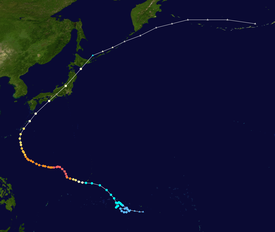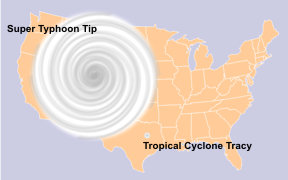Typhoon Tip
| Category 5 super typhoon (SSHWS) | |
 Typhoon Tip at its record peak intensity on October 12, 1979 | |
| Formed | October 4, 1979 |
|---|---|
| Dissipated | October 19, 1979 |
| Highest winds | 1-minute sustained: 305 km/h (190 mph) |
| Lowest pressure | 870 hPa (mbar); 25.69 inHg (Worldwide record low) |
| Fatalities | 86 direct, 13 indirect |
| Areas affected | Guam, Japan |
| Part of the 1979 Pacific typhoon season | |
Typhoon Tip was the largest and most intense tropical cyclone on record. As the nineteenth tropical storm, twelfth typhoon, and third super typhoon of the 1979 Pacific typhoon season, Tip developed out of a disturbance in the monsoon trough on October 4 near Pohnpei. Initially, a tropical storm to its northwest hindered the development and motion of Tip, though after it tracked further north Tip was able to intensify. After passing Guam, it rapidly intensified and reached peak winds of 305 km/h (190 mph) and a worldwide record low pressure of 870 mbar (hPa) (25.69 inches of mercury) on October 12. At its peak strength, it was also the largest tropical cyclone on record with a diameter of 2220 km (1380 mi). It slowly weakened as it continued west-northwestward, and later turned to the northeast under the influence of an approaching trough. Tip made landfall on southern Japan on October 19 as a minimal Category 1 typhoon, and became an extratropical cyclone shortly thereafter.
Air Force reconnaissance flew into the typhoon for 60 missions, making Tip one of the most closely observed tropical cyclones of all time.[1] Rainfall from the typhoon breached a flood-retaining wall at a United States Marine Corps training camp in the Kanagawa Prefecture of Japan, leading to a fire which injured 68 and killed 13 Marines. Elsewhere in the country, it led to widespread flooding and 42 deaths. 44 were killed or left unaccounted for due to shipwrecks offshore.
Storm history

Tropical storm (39–73 mph, 63–118 km/h)
Category 1 (74–95 mph, 119–153 km/h)
Category 2 (96–110 mph, 154–177 km/h)
Category 3 (111–129 mph, 178–208 km/h)
Category 4 (130–156 mph, 209–251 km/h)
Category 5 (≥157 mph, ≥252 km/h)
Unknown
Three circulations developed within the monsoon trough that extended from the Philippines to the Marshall Islands. A disturbance to the southwest of Guam developed into Tropical Storm Roger on October 3, and later on the same day a tropical disturbance which later became Typhoon Tip organized to the south of Pohnpei. Strong flow from across the equator was drawn into the circulation of Roger, initially preventing significant development of the disturbance which would become Tip. Despite the unfavorable air pattern, the tropical disturbance near Pohnpei gradually organized as it moved westward. Due to the large-scale circulation pattern into Tropical Storm Roger, the tropical disturbance moved erratically and slowly executed a cyclonic loop a short distance to the southeast of Chuuk. A Reconnaissance Aircraft flight into the system late on October 4 confirmed the existence of a closed low-level circulation, and early on October 5 the Joint Typhoon Warning Center issued its first warning on Tropical Depression Twenty-Three.[1]
While executing a loop near Chuuk, the tropical depression intensified into Tropical Storm Tip, though the storm initially failed to organize significantly due to the influence of Tropical Storm Roger. Reconnaissance Aircraft provided the track of the surface circulation, as satellite estimated the center being about 60 km (38 mi) from its true position. After drifting erratically for several days, Tip turned to a steady northwest motion on October 8. By the 8th, Tropical Storm Roger had become an extratropical cyclone, resulting in the southerly flow being entrained into Tip. Additionally, an area of the Tropical Upper Tropospheric Trough moved to the north of Guam, providing an excellent outflow channel the north of Tip. Initially, the storm was predicted to continue northwestward and make landfall on Guam, though early on October 9 it turned to the west, passing about 45 km (28 mi) south of the island. Later that day, Tip intensified to attain typhoon status.[1]

As a result of very favorable conditions for development, Typhoon Tip rapidly intensified in the open waters of the western Pacific Ocean. Late on October 10, the typhoon attained the equivalence of a Category 4 hurricane on the Saffir-Simpson Scale, and the next day it became a super typhoon. The central pressure dropped 92 mbar (hPa) from October 9 to 11, during which the circulation pattern of Typhoon Tip increased to a record diameter of 2220 km (1380 mi). The typhoon continued to intensify further, and early on October 12 Reconnaissance Aircraft recorded a world record-low pressure of 870 mbar (hPa) with winds of 305 km/h (190 mph) while located about 840 km (520 mi) west-northwest of Guam. At the time of its peak strength, its eye was 15 km (9.3 mi) wide.[1]
At its peak intensity, the temperature inside the eye of Typhoon Tip was 30° C (86° F) and described as exceptionally high. A weather officer on the Reconnaissance Aircraft mission at the peak intensity of Tip described an unusual double-helix spiral striation in the eye from the base of the wall cloud to the top. After peaking in intensity, Tip weakened to a 230 km/h (145 mph) typhoon and remained at that intensity for several days as it continued west-northwestward. For five days after reaching its peak strength, the average radius of winds stronger than 55 km/h (35 mph) extended over 1100 km (685 mi). On October 17, Tip began to steadily weaken as its size reduced, and the next day it began recurving northeastward under the influence of a mid-level trough. After passing about 65 km (45 mi) east of Okinawa, it accelerated its forward motion to 75 km/h (46 mph), and on October 19 Tip made landfall on the Japanese island of Honshū with winds of about 130 km/h (80 mph). The typhoon continued rapidly northeastward through the country and became an extratropical cyclone over northern Honshū a few hours after moving ashore. The extratropical remnant of Tip continued to the northeastward before losing its identity on October 21 to the east of the Kamchatka Peninsula.[1]
Impact and records

The typhoon produced heavy rainfall early in its lifetime while passing near Guam, including a total of 23.1 cm (9.09 in) at Andersen Air Force Base.[1] The outer rainbands of the large circulation of Tip produced moderate rainfall in the mountainous regions of the Philippine island of Luzon.[2]
During recurvature, Typhoon Tip passed about 65 km (40 mi) east of Okinawa. There, sustained winds reached 72 km/h) (44 mph) with gusts to 112 km/h (69 mi). Sustained winds in Japan are unknown though of at least minimal typhoon strength. The passage of the typhoon through the archipelago resulted in millions of dollars in damage to the agricultural and fishing industries of the country.[1] Eight ships were grounded or sunk by Tip, leaving 44 fishermen dead or unaccounted for. A Chinese freighter broke in half as a result of the typhoon, though its crew of 46 were rescued.[2] Heavy rainfall from the typhoon breached a flood-retaining wall at Camp Fuji, a training facility for the United States Marine Corps near Yokosuka. The fuel caught on fire, killing thirteen marines, injuring 68,[1] and causing moderate damage to the facility. The facility's barracks were destroyed,[3] along with fifteen huts and several other buildings.[4] The barracks were rebuilt,[3] and a memorial was established for those who lost their lives in the fire.[4] The rainfall led to over 600 mudslides throughout the mountainous regions of Japan, and also flooded more than 22,000 homes. 42 people died throughout the country, with another 71 missing and 283 injured.[2]
Typhoon Tip was the largest tropical cyclone on record with a diameter of 1380 miles (2220 km), almost double the previous record set by Typhoon Marge in August of 1951. It was also the most intense tropical cyclone on record with a pressure of 870 mbar (hPa), 6 mbar lower than previous record set by Super Typhoon June in 1975.[1] The records set by Tip still stand, though due to the end of routine Reconnaissance Aircraft in the western Pacific Ocean in August of 1987, modern researchers questioned if Tip is the strongest on record. After a detailed study, three researchers determined two typhoons, Angela in 1995 and Gay in 1992, maintained higher Dvorak numbers than Tip, and believed that one or both of the two may have been more intense than Tip. Due to lack of direct observations, it is unknown if Tip maintains the world record or not.[5]
See also
References
- ^ a b c d e f g h i George M. Dunnavan & John W. Dierks (1980). "An Analysis of Super Typhoon Tip (October 1979)" (PDF). Joint Typhoon Warning Center. Retrieved 2007-01-24.
- ^ a b c Debi Iacovelli and Tim Vasquez (1998). "Supertyphoon Tip: Shattering all records" (PDF). Monthly Weather Log. Retrieved 2007-01-25.
- ^ a b United States Naval Construction Force (2004). "History of the U.S. Naval Mobile Construction Battalion FOUR". Retrieved 2007-01-25.
- ^ a b "Camp Fuji Fire Memorial". United States Marine Corps. 2006. Retrieved 2007-01-25.
- ^ Karl Hoarau, Gary Padgett, and Jean-Paul Hoarau (2004). "Have there been any typhoons stronger than Super Typhoon Tip?" (PDF). American Meteorological Society. Retrieved 2007-01-24.
{{cite web}}: CS1 maint: multiple names: authors list (link)
